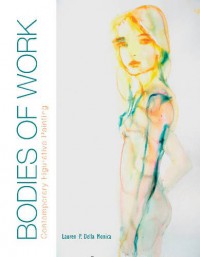

Figure studies are one of my favourite forms of art. There is such endless variance in humanity, in expressions, in forms, in postures, that for me, figure studies never get old. I will admit that my own tastes aren't particularly sophisticated. I strongly prefer the realists such as Edward Hopper, and tend to be thoroughly bemused by more abstract or avant-garde schools. So when I had the opportunity to read Bodies of Work, I jumped at the chance. The book not only introduced me to new and more challenging styles; more importantly for readers like me, it also discusses and explains the motifs and meanings of the art itself.
I found more classical styles, like that of Michael Borremans, Peri Schwartz, and Jacob Collins, to be easy to appreciate and enjoy. However, a majority of artists in the book utilize styles I found more challenging and opaque. For these artists, the pages introducing the artists and their styles were critical for me. Some of the art, particularly that with more childish, whimsical styles, never really grew on me, even though the book gave me a better understanding of the emotive underpinnings. One of the most difficult sections of the book for me was that of "body as form," where the human figure was construed in terms of line and colour, and often distorted in ways I found difficult to enjoy. The chapter on narrative painting was more interesting, demonstrating, to my mind, how art intended to tell a story puts significantly more emphasis and complexity into the background and surroundings of the figures.
Many of the artists whose work is presented in Bodies of Work, such as Ahmed Alsoudani, Whitefield Lovell, Kerry James Marshall, and Hayv Kahraman, use figurative art as a means of social commentary. An entire chapter of the book is set aside to figurative paintings used as social statement. I was particularly intrigued by Kehinde Wiley, who reimagines classical works with contemporary African-American figures set against clashing, complex, vibrant tangles of plants and flowers, and Titus Kaphar, who creates revisionist history paintings that give expression to the mute voices of history. Liu Xiadong's beautiful, expressive paintings of contemporary life in China were easy for me to appreciate, both in terms of artistic beauty and social content.
If you're interested in figurative art, particularly in a wide array of styles and emphasises, and you're looking for something to help guide your interpretation and sharpen your vision, I heartily recommend Bodies of Work.
~~I received an advanced reader copy of this ebook through Netgalley from the publisher, Schiffer Publishing Ltd, in exchange for my honest review.~~

 13
13




